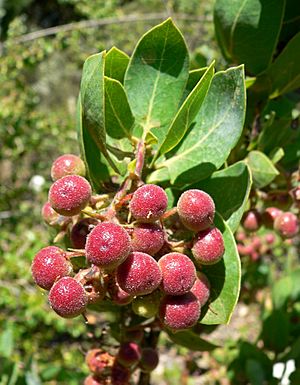Bigberry manzanita facts for kids
Quick facts for kids Bigberry manzanita |
|
|---|---|
 |
|
| Conservation status | |
| Scientific classification | |
| Kingdom: | |
| (unranked): | |
| (unranked): | |
| (unranked): | |
| Order: | |
| Family: | |
| Genus: | |
| Species: |
A. glauca
|
| Binomial name | |
| Arctostaphylos glauca |
|
Arctostaphylos glauca is a type of plant called a manzanita. It's often known as the bigberry manzanita because of its large fruits. This plant grows naturally in California and Baja California. You can find it in dry, shrubby areas called chaparral and in woodlands on hills near the coast and further inland.
Contents
About the Bigberry Manzanita
The bigberry manzanita is a large shrub. It can grow from one meter (about 3 feet) to over six meters (about 20 feet) tall. Plants growing in desert areas are usually shorter than those near the coast.
Its leaves are a light gray-green color and feel a bit waxy. They are oval or nearly round. Their edges can be smooth or have small teeth. These leaves are about five centimeters (2 inches) long and four centimeters (1.5 inches) wide. They grow on short stems called petioles, which are about one centimeter (less than half an inch) long.
Flowers and Fruit
The plant produces hanging groups of white flowers. These flowers are shaped like small urns. The plant's fruit is round or egg-shaped and can be eaten. It is a type of fruit called a drupe, like a peach or cherry. Each fruit is about 12 to 15 millimeters (half an inch) wide. The fruit is light red and has a thick inside part covered by a tough, sticky skin. Inside the fruit, there are three to six small seeds, called nutlets, that are joined together.
How it Grows
The bigberry manzanita grows from seeds and also by a process called layering. This is when a branch touches the ground and grows roots, forming a new plant. For the seeds to sprout, they need to be exposed to fire. This helps them break open and start growing.
This plant can live for a long time, often more than 100 years! However, it doesn't start making fruit until it's about 20 years old. The bigberry manzanita is also an allelopathic plant. This means it can stop other plants from growing nearby. It does this by releasing natural chemicals like arbutin and phenolic acids from its leaves when it rains. These chemicals can be harmful to other plants.
Uses of the Bigberry Manzanita
Long ago, the Native Americans in California used the fruits of the bigberry manzanita. They would eat the ripe fruits. They also made a type of cider drink from them.
See also
 In Spanish: Arctostaphylos glauca para niños
In Spanish: Arctostaphylos glauca para niños


